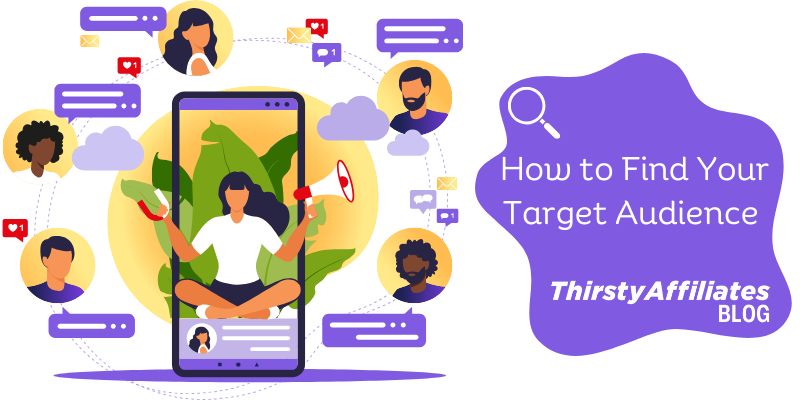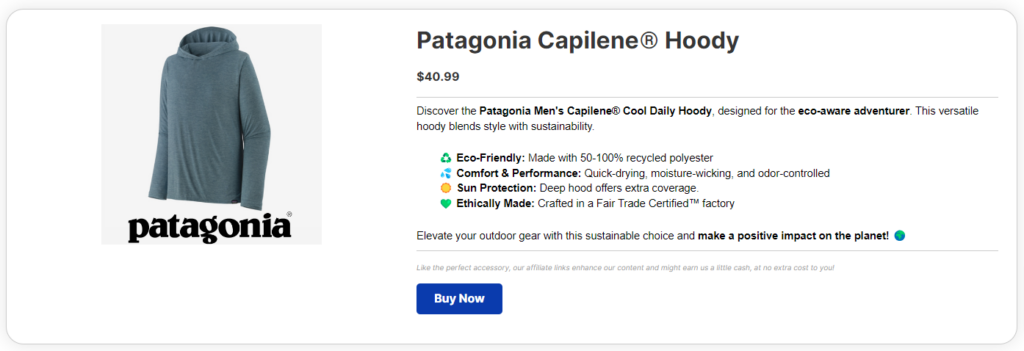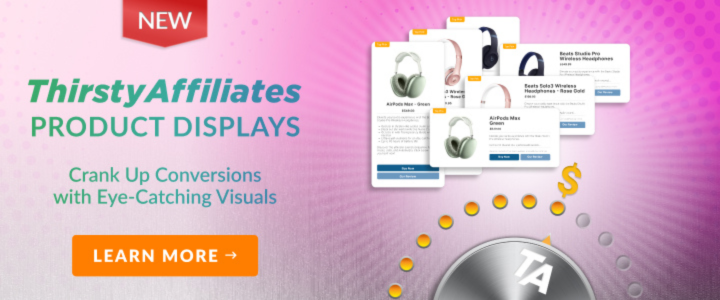Contents

In the digital marketplace, where every click counts and competition is fierce, making sure your promotional efforts hit the mark is more important than ever.
With an ocean of content out there, it’s all too easy for your work to get lost if it doesn’t speak directly to someone specific.
Spreading your message too thin across a wide audience often leads to it falling flat, while targeting too narrowly might not give your content the legs it needs. The challenge is finding and engaging with the right audience for the products you promote.
But how do you ensure your promotions reach those who are genuinely interested?
The answer lies in creating a concise target audience profile. This approach is more than making guesses; it’s about actively getting to grips with the wants and needs of your target market.
By honing in on your ideal audience, you ensure the products you showcase are exactly what they're looking for.
This article will guide you through the simple, 4-step process of building an audience profile that’s as effective as your promotions, aiming to bridge the gap between your content and the people it’s meant for.
Understanding Your Target Audience (and Why It Matters)
Your ideal audience consists of people who are most likely to be excited about and find value in your promotions, products, and services.
Recognizing who they are enables you to tailor your promotions, products, and services to meet their needs and interests, thereby enhancing the likelihood of sales and conversions.

Sketching out this profile involves detailing the characteristics that define your potential customers. This process helps in understanding their preferences and behaviors.
Consider the following aspects when defining your target audience:
- Demographics: Include age, gender, location, income level, and education. These factors help in identifying the basic outline of the audience you aim to reach.
- Behavior: Look into their purchasing history, how they use products, and their daily habits. This insight helps in understanding how your offerings fit into their lives.
- Psychographics: Focus on their interests, values, lifestyle choices, and personality traits. This dimension adds depth to your audience profile, offering clues on how to engage them emotionally and intellectually.
Buyer personas, or target audience profiles, are foundational to your marketing strategy. They ensure that your messaging remains consistent, impactful, and drives personalized conversions.
How to Build a Target Audience Profile (In 4 Steps)
Chances are, you've got a rough sketch in your mind of who your ideal customers might be. Maybe you've been tuning into their feedback, poring over testimonials, or leaning into social proof to bolster your marketing.
That's a solid foundation to build on.
But getting down to the nitty-gritty with a full-on target audience profile can really change the game. It helps you get super clear on what your customers are into and how you can make their day.

Don’t worry, putting one together is more about being curious and doing a bit of detective work than anything else.
Step 1: Figure Out Who's Into Your Product Recommendations
This initial step doesn't require diving into specific details like demographics right away. Instead, focus on the broader reasons behind their preference for your brand.
Think about the relationship customers have with your products. What drives them to choose your recommendations over the competition?
More questions to explore include:
- What distinguishes your product in their eyes?
- Do they need a bit of a nudge to see how awesome it is, or does it click right away?
- Are they all about the big picture of what you offer, or do they zero in on specific bits?
For example, let’s say you're in the affiliate business of promoting eco-friendly activewear. Picture someone like Alex:
Alex is a fitness enthusiast who's passionate about sustainability. He's always on the lookout for workout gear that not only fits well but also aligns with his values of reducing environmental impact. He's tried the usual brands but feels they fall short in their eco-commitments.
For someone like Alex, the appeal might be in sustainable materials and a brand's dedication to eco-friendly practices.

Through beautifully designed ThirstyAffiliates Product Displays, you can showcase eco-friendly activewear products and brands that prioritize sustainable materials and eco-friendly manufacturing practices.
By presenting these options in a visually appealing format, you're not just advertising products; you're telling a story that Alex and like-minded consumers can connect with.
This scenario helps you get a grip on what's important to your potential customers, making it easier to connect with them on a level that resonates.
Step 2: Dive Deeper into Who Your Customers Really Are
With a basic outline of who's interested in your products, now it's time to flesh out that picture with more detailed information.
Demographics
Including demographic information in your target audience profile will help you better understand your customer base.
Adding demographics to your target audience profile gives you a clearer view of who your customers are. Some demographic details might be straightforward to figure out.

For instance, if you're promoting beauty or fashion products, it's likely your primary audience is women.
Other demographics may require more research to identify, such as discovering their:
- Age
- Location
- Job and income
- Family status
- Preferred social media sites
Researching demographics is the most fundamental part of your target audience profiling research. However, there’s a lot more research you can do.
Behaviors
Next, consider the behavior patterns of your target customers. Understanding their day-to-day actions can give you insight into their purchasing decisions.
Questions to explore include:
- What does a typical day for them look like?
- What other products do they purchase regularly?
- How do they research products before making a purchase?
- Which shopping platforms or stores do they prefer, both online and offline?

This info can guide you in finding ways for your brand to naturally fit into their daily routines and preferences.
Psychographics
Consumer psychographics goes right to the heart of who your customers are and what drives and motivates them.
Some areas to explore for psychographic information include:
- Personality traits: Are they more introverted or extroverted? Do they make decisions based on logic or emotion?
- Core values: What's important to them? This could range from being family-oriented to valuing environmental sustainability.
- Beliefs: This can encompass a wide range of areas, including religion, spirituality, and cultural or societal views.
- Interests and hobbies: What do they enjoy doing? This could include anything from sports and music to reading and cooking.

This information will help you build a three-dimensional picture of the makeup of your target audience.
Step 3: Identify the Needs and Problems of Your Target Audience
By now, you have a good idea of who your ideal customers are. Next, you'll need to identify their needs and pain points.
Put yourself in the shoes of your potential customers, and look at your products or services from their point of view. What motivates them to buy?
Some other questions to consider include:
- Are there any particular problems they're hoping to solve by using what you offer?
- What might be holding them back from hitting the buy button?
- What needs do they have that your product or service fits perfectly?
By understanding these points, you can tweak how you talk about products to hit right where it matters for your customers.
Step 4: Make Sure Your Products are in the Right Place
The final step is all about visibility. It's great having awesome products on your website, but if potential customers don’t know they exist or can't find them;
- They're missing out on some cool stuff.
- You’re missing out on scoring a commission.
Think about how your customers are likely to stumble across your website. This requires finding out where they already spend their time online and asking questions such as:
- What websites do they visit?
- What blogs do they read?
- Which social media sites are they on?
- What search terms they're using?
- What types of content keeps them clicking?
The trick is to pop up in the places they already like and trust. It’s about making it super easy for them to bump into your products and go, “Hey, this is pretty cool!”
Putting Your Target Audience Profile to Work
Now that you've got a solid target audience profile in hand, what's the plan?
Let this profile be the guide for all your marketing strategies. It's about picking the right social media channels, ensuring your website is packed with content that resonates with your audience, and even influencing the tone and approach of your messaging.
What Next?
Got all that juicy audience info and wondering what to do with it? It's time to get even smarter with your approach by breaking down your audience into smaller, more specific groups.
For instance, in the technology niche market, you might identify several specific segments, such as:
- College students scouring budget-friendly laptops suitable for writing papers, and on-the-go study sessions.
- Parents on the hunt for child-friendly tablets that offer educational apps and robust parental controls.
- Fitness Enthusiasts looking for wearable fitness trackers that monitor health metrics and sync with mobile apps.
- Teachers exploring smart board options that enhance interactive learning and engagement in the classroom.
- Gamers seeking the latest gaming consoles or high-spec gaming PCs that offer immersive gameplay.

Each group has unique needs, preferences, and motivations, which means a one-size-fits-all approach won't cut it.
Here's where tools like ActiveCampaign and HubSpot come in handy.
- ActiveCampaign is your go-to for slicing and dicing your email list into neat segments. This way, you can shoot over emails that speak directly to what each group is into, making every message count.
- Hubspot can help you spot different audience segments you might not even know you had. It’s great for keeping track of how each group interacts with your content, letting you tweak your strategy for the win.
Segmenting your audience lets you get personal without getting all up in their business. The goal? Making sure your marketing feels like a one-on-one convo, boosting engagement, conversions, and, ultimately, making your audience feel seen.
Conclusion
Without a clearly defined target audience, much of your marketing efforts will fall on deaf ears. A well-defined target audience profile is crucial for crafting content that genuinely engages and attracts potential customers.
To create this profile, just follow these steps:
- Outline broad characteristics of your ideal customers.
- Delve into their demographics, behaviors, and deeper motivations.
- Identify their specific needs and challenges.
- Figure out the platforms they're most likely to discover your offerings.
Need help deciphering the demographics, behaviors, and psychographics of your audience? Seeking advice on crafting compelling messages that resonate with different segments of your audience? Ask away in the comments section below. We've got answers!
If you liked this post, be sure to follow us on Twitter, Instagram, Facebook, Pinterest, and LinkedIn! And don't forget to subscribe to our newsletter!




Knowing who your ideal customer is will help you to select the best product(s) to sell to them. By identifying who your prospects are, you’ll know where to reach them, what to say to them, and how to approach them with your sales offer.
Building a target audience profile is one of the hardest parts of marketing for me. But if one must succeed in the marketing field, knowing one potential buyer is a must and must be mastered. Thanks for this masterpiece
This is gold! Building a target audience profile is key to effective marketing. Understanding your audience’s demographics, behavior, and psychographics is essential for delivering tailored messaging and driving conversions. Thanks for sharing this valuable guide! ✨
Making a target client profile is very necessary for everyone thanks
Hello there,
Your tips for target the audience help me a lot keep posting this type of content.
Crafting a target audience profile is crucial for effective marketing. This insightful guide equips you with practical steps to understand your audience better, enabling you to tailor your strategies and engage with precision
One of the most challenging aspects of marketing are the construction of a target audience. This article was super helpful for me as a digital marketer. In order to totally understand our audience, we must become a part of the process and try to understand the buyer’s journey as well as personas. Thanks for sharing this valuable information and I am looking forward to learn more from you! Cheers!
An insightful guide on building a target audience profile! These 4 steps provide a clear framework to understand and engage with your audience effectively. Thank you for sharing this valuable resource!
Thank you for sharing this insightful blog post! I found the information to be particularly interesting. The way you explained was clear and easy to understand. It’s great to see such valuable content that provides practical knowledge for readers. Keep up the fantastic work! Looking forward to reading more from you.
What a wonderful information provided, from introduction about affiliated marketing till conclusion, I was looking for generating audience through affiliated marketing and land up here, thanks Victoria for sharing valuable tips!
Thanks for sharing this valuable post with us. !!
Thanks for a great article as always!
What strategies can be used to identify the specific needs and problems of a target audience when creating a target audience profile?
-RobinEsson
i have learned how to target audience based on our requirement. thanks for the blog.
I really appreciate your content for giving us such knowledge and the first time I read it I has been interested in your content. Once again thanks for making such knowledgeable content.
i have found very intresting knowledge in this article .i helps me in my affiliate startup
Hi Victoria,
Great article on how to build a target audience profile. I’ve been working on my own affiliate marketing business for a few years now, and I’ve definitely learned the importance of having a clear understanding of my target audience.
I think one of the most important things you mentioned is the need to include psychographic data in your target audience profile. This is often overlooked, but it can be just as important as demographic data when it comes to understanding your audience’s needs and wants.
For example, I know that my target audience is mostly female, between the ages of 25 and 45, and they live in urban areas. But I also know that they are interested in health and wellness, they are active on social media, and they are always looking for new ways to save money.
This psychographic data helps me to create marketing campaigns that are more relevant and engaging to my audience. For example, I know that they are interested in reading blog posts about healthy recipes, so I make sure to include that type of content in my marketing. I also know that they are active on social media, so I make sure to promote my affiliate products on social media platforms like Instagram and Pinterest.
I think your article is a great resource for anyone who is looking to build a successful affiliate marketing business. Thanks for sharing!
Thanks for giving valuable information to us.
Thanks for giving valuable information to us.
Great article.
Building a target audience is a challenging aspect of marketing.
You explained it in a simple and easy way.
I found the information interesting.
Thanks for sharing this article.
Thank you so much for sharing this valuable guide on How to Build a Target Audience Profile! Your insights and tips have been incredibly helpful in understanding our audience better and crafting more targeted strategies.
Thank you for your dedication to providing valuable content. It’s evident that you genuinely care about helping your readers succeed and thrive. I’m eagerly looking forward to implementing your suggestions and seeing positive results.
Cheers guys, appreciate the time you have taken to put this info together. Super useful. Have a great weekend.
Great read! Your guide on building a target audience profile in four simple steps is incredibly useful. Understanding your audience is at the core of effective marketing, and your tips make the process more accessible. The step-by-step approach and practical examples provide valuable insights for anyone looking to refine their marketing strategy. Thanks for sharing your expertise and helping us connect with our audience more effectively!
I’ve always struggled with building an audience, never mind building a target audience. Thanks for all your tips! Never too late to learn!
Awesome article.
One of the more difficult aspects of marketing is creating a target audience.
You did a good job of simplifying the explanation.
The details piqued my interest.
We appreciate you sharing this content.
Building a target audience profile is a crucial step in marketing and business strategy.
Online earning is an incredible opportunity that can transform your financial situation and lifestyle. It’s a realm of possibilities limited only by your imagination and dedication. However, success in this space doesn’t happen overnight. It’s a journey that requires hard work, learning from failures, and continuous adaptability. Keep your goals in sight, stay persistent, and always remember that success in online earning is as much about adding value to others as it is about generating income. Stay committed to your path, and you’ll find that the rewards are well worth the effort.
Absolutely nailed it. This article is what I was searching for!!! Big shout out to the writer.
Hi,
I appreciate your commitment to delivering meaningful content. It’s clear that you truly have your readers’ success and growth at heart. I am excited to apply your advice and anticipate favorable outcomes.
Thanks
This blog post provides a clear and concise overview of how to build a target audience profile, a crucial step for any business or organization that wants to effectively market its products or services. The author breaks down the process into four simple steps, making it easy to follow and implement.
Hi,
Nice article! I want to know how to set up a Google Ads campaign specifically for calls. Is there a specific strategy for Google Ads? Please guide me because I’ve already spent $1000 on the campaign, and I haven’t received any calls from the ads.
Hey Dndaims ! Yes, you have to optimize your campaign for calls, especially for smartphones. Create a unique strategy and funel, to get those clients in contact. But remember, depends on the niche, this might not be the best choice.
Thank you so much for sharing this amazing information keep updating us.
You’re absolutely right! Without a clearly defined target audience, your marketing efforts will be like shouting into the void, hoping that someone will hear your message. Building a target audience profile is the essential first step to crafting effective marketing strategies and connecting with potential customers on a deeper level.
I believe before starting any kind of business researching the target audiences is a must. We must know for whom we are going to do business. You’ve given some cool pieces of information. Thanks
This is definitely great and interesting information for beginners who are more confident and ready to do this job.
Very Nice Blog Content for the Target Audience Profile.
Thank you so much for sharing this amazing information ,i am getting really good knowledge from this
Fantastic post! Building a target audience profile is undoubtedly the cornerstone of any successful marketing strategy, and your comprehensive guide breaks down the process with clarity and precision. Your insights into understanding customer demographics, psychographics, and behaviors are invaluable. The actionable tips and examples provided make it easier for both beginners and seasoned marketers to create profiles that resonate.
Appreciate the emphasis on the dynamic nature of audience profiles, highlighting the importance of regular updates to stay aligned with shifting market trends. Your commitment to delivering high-quality content shines through, and I can’t thank you enough for sharing your expertise. Looking forward to implementing these strategies and witnessing the positive impact on our marketing efforts. Keep up the excellent work!
Really Great Blog, it will help me a lot to build a target audience. Thank you so much for sharing this information with us.